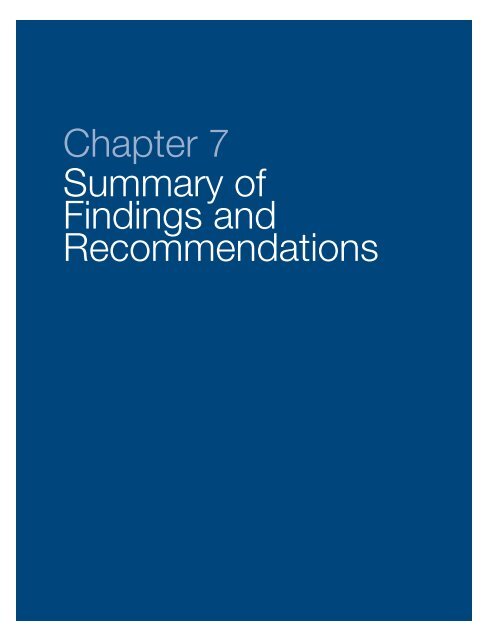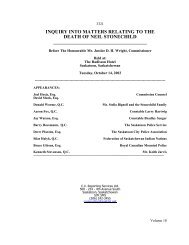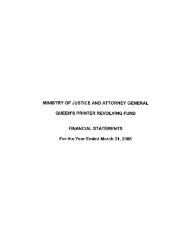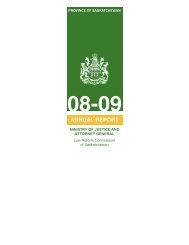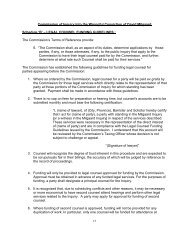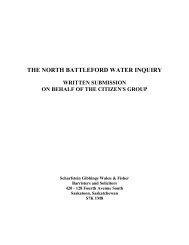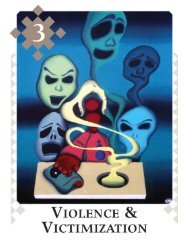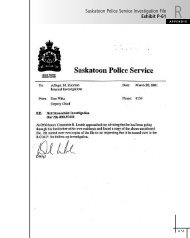Chapter 7 Summary of Findings and Recommendations
Chapter 7 Summary of Findings and Recommendations
Chapter 7 Summary of Findings and Recommendations
Create successful ePaper yourself
Turn your PDF publications into a flip-book with our unique Google optimized e-Paper software.
<strong>Chapter</strong> 7<br />
<strong>Summary</strong> <strong>of</strong><br />
<strong>Findings</strong> <strong>and</strong><br />
<strong>Recommendations</strong>
<strong>Summary</strong> <strong>of</strong> <strong>Findings</strong><br />
I. The Conduct <strong>of</strong> the Investigation into the Death <strong>of</strong> Gail Miller<br />
(a)<br />
General <strong>Findings</strong> Regarding 1969 Police Investigation into the Death <strong>of</strong> Gail Miller<br />
1. The Saskatoon Police <strong>and</strong> the RCMP conducted a thorough <strong>and</strong> appropriate investigation<br />
<strong>of</strong> the Gail Miller murder.<br />
2. The crime scene was appropriately preserved, examined, <strong>and</strong> recorded.<br />
(b)<br />
Police Interaction with Key Witnesses<br />
(i)<br />
Albert Cadrain<br />
3. The evidence <strong>of</strong> Albert Cadrain was not improperly obtained by the police. Cadrain came<br />
to the Saskatoon Police voluntarily on March 2, 1969 <strong>and</strong> provided incriminating evidence<br />
against David Milgaard. No police pressure was exerted upon Cadrain to implicate<br />
Milgaard. The allegation that the police mistreated Cadrain <strong>and</strong> coerced incriminating<br />
evidence from him is unsupported by the facts <strong>and</strong> without merit.
<strong>Chapter</strong> 7 <strong>Summary</strong> <strong>of</strong> <strong>Findings</strong> <strong>and</strong> <strong>Recommendations</strong><br />
4. Albert Cadrain was rational <strong>and</strong> showed no overt indications <strong>of</strong> being mentally ill at the time<br />
he gave his statement <strong>of</strong> March 2, 1969 <strong>and</strong> when he testified at trial. His mental illness, first<br />
diagnosed in 1973, was not apparent to investigators or prosecutors prior to David Milgaard’s<br />
conviction (even if it existed before then). The police were justified in relying upon Cadrain <strong>and</strong><br />
his evidence was h<strong>and</strong>led appropriately throughout.<br />
(ii) Initial Statements <strong>of</strong> Nichol John <strong>and</strong> Ron Wilson<br />
5. The initial police statements <strong>of</strong> Ron Wilson <strong>and</strong> Nichol John did not include complete details <strong>of</strong><br />
their activities on the morning <strong>of</strong> January 31, 1969. Continued questioning <strong>of</strong> these witnesses<br />
by the police was justified.<br />
6. The decision to have Inspector Art Roberts <strong>of</strong> the Calgary Police Service conduct a polygraph<br />
test on Ron Wilson <strong>and</strong> Nichol John was reasonable. The summary prepared by Detective<br />
Sergeant Raymond Mackie was intended as an investigative aid <strong>and</strong> not as a blueprint for<br />
a case police were constructing against David Milgaard. The allegation that the Mackie<br />
<strong>Summary</strong> was prepared as a script for the police to follow in obtaining evidence from John<br />
<strong>and</strong> Wilson is without foundation.<br />
7. After their initial police statements <strong>and</strong> prior to being interviewed by Art Roberts, Ron Wilson<br />
<strong>and</strong> Nichol John provided the police with further details <strong>of</strong> their activities on January 31,<br />
1969. In particular, they told the police they stopped a woman for directions, that shortly<br />
thereafter their vehicle became stuck in the vicinity <strong>of</strong> the murder <strong>and</strong> that David Milgaard <strong>and</strong><br />
Wilson left the vehicle in separate directions looking for help. Their accounts were generally<br />
consistent with what Milgaard had told his trial counsel, except with respect to the length <strong>of</strong><br />
time Milgaard was away from their stuck vehicle. Wilson said it was 15 minutes, Milgaard said<br />
it was a short time <strong>and</strong> John said she was unable to recall.<br />
(iii) Ron Wilson<br />
8. In his May 23, 1969 interview with Art Roberts, Ron Wilson did not initially implicate David<br />
Milgaard in Gail Miller’s murder. Roberts conducted a polygraph examination testing the<br />
veracity <strong>of</strong> Wilson’s evidence, <strong>and</strong> then advised Wilson that the polygraph showed he was<br />
not being truthful in answering certain questions relating to Milgaard’s involvement in Miller’s<br />
murder. Wilson responded by changing his evidence to directly implicate Milgaard. He<br />
provided new information, which included an alleged confession by Milgaard, an identification<br />
<strong>of</strong> the murder weapon <strong>and</strong> an observation <strong>of</strong> blood on Milgaard’s clothing. Roberts did not<br />
test the truthfulness <strong>of</strong> Wilson’s new inculpatory evidence by polygraph.<br />
9. Ron Wilson was turned over to the Saskatoon Police to whom he provided two written<br />
statements verifying the new information he disclosed to Art Roberts after the polygraph<br />
session.<br />
10. The inculpatory evidence Ron Wilson provided to Art Roberts <strong>and</strong> the Saskatoon Police after<br />
the polygraph test is now known to have been unreliable.<br />
11. The Commission lacks evidence to conclude that Art Roberts resorted to outright coercion<br />
during his interview with Ron Wilson, but whatever he said to him did not produce the truth. In<br />
the course <strong>of</strong> the polygraph examination <strong>and</strong> interview, Roberts somehow caused Wilson to<br />
tell him what Roberts thought to be the truth.<br />
400
<strong>Chapter</strong> 7 <strong>Summary</strong> <strong>of</strong> <strong>Findings</strong> <strong>and</strong> <strong>Recommendations</strong><br />
12. There was a critical failure to record the circumstances <strong>of</strong> Art Roberts’ interview <strong>and</strong> polygraph<br />
<strong>of</strong> Ron Wilson including the questions asked <strong>and</strong> the polygraph results. Roberts did not<br />
provide a report <strong>of</strong> the interview <strong>and</strong> polygraph session.<br />
13. Detective Eddie Karst was a highly experienced, honest <strong>and</strong> skilled investigator. He did not<br />
improperly induce Ron Wilson to make the statements that he gave on May 23 <strong>and</strong> 24, 1969.<br />
14. The Saskatoon Police honestly <strong>and</strong> reasonably believed that Ron Wilson’s inculpatory<br />
evidence provided to Art Roberts had been verified by the polygraph as being truthful, when it<br />
had not. In the circumstances, it was reasonable for the Saskatoon Police to rely on Wilson’s<br />
evidence.<br />
(iv) Nichol John<br />
15. After the polygraph session with Ron Wilson, Art Roberts interviewed Nichol John. She<br />
initially denied that David Milgaard was involved in Gail Miller’s murder, but after continued<br />
questioning by Roberts she told him that she just remembered witnessing Milgaard commit<br />
the murder. John was turned over to the Saskatoon Police <strong>and</strong> the next day gave a written<br />
statement to Raymond Mackie confirming the evidence she reported to Roberts.<br />
16. The Commission lacks evidence to conclude that Art Roberts resorted to outright coercion<br />
during his interview with Nichol John, but whatever he said to her did not produce the truth.<br />
Roberts somehow pressured John into telling him what he thought to be the truth. There<br />
is a clear distinction to be made between coercing evidence from a witness in the sense <strong>of</strong><br />
compelling assent or belief <strong>and</strong> using persuasive techniques such as repetitive questioning<br />
<strong>and</strong> suggestion.<br />
17. There was a critical failure to record the circumstances surrounding Art Roberts’ interview<br />
<strong>of</strong> Nichol John <strong>and</strong> the taking <strong>of</strong> John’s statement by Raymond Mackie on May 24, 1969.<br />
Neither Roberts nor Mackie left a report as to the circumstances surrounding John’s<br />
statement which must now be seen as the result <strong>of</strong> pressure by Roberts.<br />
18. There is no evidence before the Commission to suggest that Nichol John was mistreated by<br />
the Saskatoon Police while staying in the cells on May 23, 1969 or that she was “hysterical”.<br />
The origin <strong>of</strong> this story appears to be the 1981 interview <strong>of</strong> John where Joyce Milgaard told<br />
John her impression <strong>of</strong> what happened.<br />
(v) David Milgaard<br />
19. David Milgaard was cooperative with the police <strong>and</strong> provided blood, hair <strong>and</strong> saliva samples<br />
when requested <strong>of</strong> him.<br />
20. David Milgaard was interviewed <strong>and</strong> questioned by the police in an appropriate manner. While<br />
Milgaard was cooperative, the police found some <strong>of</strong> his answers to be evasive. Milgaard could<br />
not initially give an accurate account <strong>of</strong> his whereabouts or his activities on the morning <strong>of</strong><br />
January 31, 1969.<br />
401
<strong>Chapter</strong> 7 <strong>Summary</strong> <strong>of</strong> <strong>Findings</strong> <strong>and</strong> <strong>Recommendations</strong><br />
21. David Milgaard denied any involvement in the Gail Miller murder. However, the information<br />
he provided to the police confirmed that on the morning <strong>of</strong> January 31, 1969 he was in the<br />
general vicinity <strong>of</strong> the murder around the time it took place. He was looking for the Albert<br />
Cadrain residence located approximately one block from where Gail Miller’s body was found,<br />
had stopped a woman to ask for directions <strong>and</strong> had been traveling in back lanes <strong>and</strong> became<br />
stuck in an alley.<br />
22. Information provided to the police by one <strong>of</strong> David Milgaard’s girlfriends in March, 1969 gave<br />
the police reason to believe that Milgaard was a person capable <strong>of</strong> a violent crime, even<br />
though his record revealed no such convictions.<br />
23. In light <strong>of</strong> what the police knew in May, 1969, it was reasonable for them to focus on David<br />
Milgaard as a suspect for the murder <strong>and</strong> to continue to question Albert Cadrain, Ron Wilson<br />
<strong>and</strong> Nichol John.<br />
(vi) Motel Room Incident Witnesses<br />
24. In a motel room in May, 1969, David Milgaard pretended to stab a pillow uttering words to the<br />
effect that he stabbed, raped <strong>and</strong> killed Gail Miller. Each <strong>of</strong> his friends who were in the motel<br />
room have slightly different recollections <strong>of</strong> the precise words used; however, they all confirm<br />
that Milgaard stated that he stabbed <strong>and</strong> killed Miller. Milgaard admitted to his trial counsel,<br />
Calvin Tallis, that he was in the motel room with these people but was so stoned that he could<br />
not remember what he said <strong>and</strong> did, explaining that if he said <strong>and</strong> did what was attributed to<br />
him, it would have been a joke.<br />
25. The police properly investigated <strong>and</strong> dealt with the motel room witnesses <strong>and</strong> were correct in<br />
bringing the motel re-enactment evidence to the prosecutor’s attention.<br />
(c)<br />
Autopsy <strong>and</strong> Forensic Investigation<br />
26. Staff Sergeant Bruce Paynter’s testing <strong>of</strong> the frozen substance found in the snow near Gail<br />
Miller’s body was proper <strong>and</strong> he accurately confirmed it to be human semen. His search <strong>of</strong> the<br />
garments for semen stains met the expected st<strong>and</strong>ard <strong>of</strong> the day, given the tools available to<br />
him.<br />
27. Vaginal aspirate from the victim was collected at the autopsy, found to contain semen <strong>and</strong><br />
discarded. The victim’s clothing was removed <strong>and</strong> left temporarily on the floor <strong>of</strong> the autopsy<br />
room exposing it to contamination. Both actions represented lapses in acceptable procedure,<br />
although they did not contribute to the wrongful conviction.<br />
(d)<br />
Investigation <strong>of</strong> Sexual Assaults <strong>and</strong> Larry Fisher<br />
28. During the course <strong>of</strong> the Gail Miller murder investigation through to the time <strong>of</strong> David<br />
Milgaard’s conviction, Larry Fisher was not known to the Saskatoon Police. He was not a<br />
suspect in Miller’s murder nor in the three attacks on Saskatoon women he committed in the<br />
months preceding Miller’s murder.<br />
29. Larry Fisher was interviewed by Saskatoon Police at the bus stop at Avenue O <strong>and</strong><br />
20th Street on February 3, 1969. He was interviewed as a potential witness <strong>and</strong> not as a<br />
suspect. Nothing in the police interview <strong>of</strong> Fisher gave reason for suspicion. Fisher escaped<br />
detection because he appeared to be just another passenger on a bus that Gail Miller used.<br />
402
<strong>Chapter</strong> 7 <strong>Summary</strong> <strong>of</strong> <strong>Findings</strong> <strong>and</strong> <strong>Recommendations</strong><br />
30. The three sexual assaults committed in Saskatoon in the fall <strong>of</strong> 1968 were diligently<br />
investigated by the Saskatoon Police <strong>and</strong> they later considered the possibility that the<br />
perpetrator <strong>of</strong> these assaults was also the killer <strong>of</strong> Gail Miller. David Milgaard became a<br />
suspect for the murder on March 2, 1969, but not for the sexual assaults, so police interest in<br />
a connection between the crimes gradually diminished.<br />
31. The police did not overlook or ignore any evidence then available to them which would have<br />
linked the 1968 sexual assaults or Larry Fisher to the Gail Miller murder.<br />
32. The police dealt appropriately with the complaint <strong>of</strong> a woman who was indecently assaulted<br />
on January 31, 1969 at 7:07 a.m., approximately seven blocks from the murder scene. The<br />
complaint was investigated for a possible connection to the Gail Miller murder. Due to the time<br />
<strong>of</strong> the assault, the distance from the Miller murder scene <strong>and</strong> the difference in the severity<br />
<strong>of</strong> the attacks, the police reasonably concluded that the complaint was unconnected to the<br />
Miller murder.<br />
(e)<br />
Allegations <strong>of</strong> Police Misconduct<br />
33. The issue <strong>of</strong> police misconduct was squarely before this Commission <strong>of</strong> Inquiry <strong>and</strong> there<br />
is no evidence that any police <strong>of</strong>ficer or police force was guilty <strong>of</strong> misconduct during the<br />
investigation <strong>of</strong> Gail Miller’s death.<br />
34. There is no evidence that David Milgaard was framed by the Saskatoon Police or any police<br />
<strong>of</strong>ficer. Based on the evidence gathered by the police, investigating <strong>of</strong>ficers held an honest<br />
<strong>and</strong> reasonable belief that Milgaard was responsible for the crime.<br />
35. The police investigated more than 200 individuals as potential suspects in connection with<br />
Gail Miller’s death. After David Milgaard became a suspect on March 2, 1969, the police<br />
continued to investigate other people, including at least 38 individuals <strong>of</strong> interest.<br />
36. The police did not suffer from tunnel vision, which I take to mean focusing on David Milgaard<br />
as a suspect to the exclusion <strong>of</strong> all others. Rather, the Inquiry evidence showed that the police<br />
followed every lead they could identify, including the theory that one perpetrator could have<br />
been responsible for the 1968 sexual assaults <strong>and</strong> the Gail Miller murder.<br />
37. The bone h<strong>and</strong>led hunting knife found near the murder scene a number <strong>of</strong> weeks after the<br />
murder was irrelevant <strong>and</strong> unconnected to Gail Miller’s murder. The knife was provided by<br />
the Saskatoon Police to the prosecutor <strong>and</strong> disclosed to David Milgaard’s defence counsel.<br />
The allegation <strong>of</strong> misconduct with respect to the alleged disappearance <strong>of</strong> the knife is without<br />
merit.<br />
II.<br />
(a)<br />
Conduct <strong>of</strong> the Criminal Proceedings<br />
Prosecutor T.D.R. Caldwell<br />
(i)<br />
General<br />
38. T.D.R. Caldwell acted in good faith throughout the prosecution <strong>of</strong> David Milgaard.<br />
39. T.D.R. Caldwell’s conduct did not contribute to the wrongful conviction <strong>of</strong> David Milgaard.<br />
Caldwell <strong>of</strong>fered evidence which he believed to be credible <strong>and</strong> relevant <strong>and</strong> did so in a spirit<br />
<strong>of</strong> cooperation with defence counsel.<br />
403
<strong>Chapter</strong> 7 <strong>Summary</strong> <strong>of</strong> <strong>Findings</strong> <strong>and</strong> <strong>Recommendations</strong><br />
40. T.D.R. Caldwell provided full cooperation to Calvin Tallis at trial.<br />
(ii) Motel Room Incident<br />
41. The accusation that T.D.R. Caldwell paid Craig Melnyk <strong>and</strong> George Lapchuk for their<br />
testimony at the David Milgaard trial in 1970 is false.<br />
42. T.D.R. Caldwell did not promise Craig Melnyk <strong>and</strong> George Lapchuk favors for their testimony.<br />
(iii) Disclosure<br />
43. At the time <strong>of</strong> David Milgaard’s trial, T.D.R. Caldwell <strong>and</strong> Calvin Tallis were not aware <strong>of</strong> the<br />
1968 sexual assaults nor <strong>of</strong> any possible connection to Gail Miller’s murder. The Saskatoon<br />
Police did not provide Caldwell with the police files relating to the unsolved 1968 sexual<br />
assaults nor did they inform Caldwell that the police considered a possible connection<br />
between the sexual assaults <strong>and</strong> the Miller murder.<br />
44. T.D.R. Caldwell’s disclosure to Calvin Tallis met the st<strong>and</strong>ards <strong>of</strong> the day. Due account was<br />
taken <strong>of</strong> the prosecutor’s discretion in deciding what evidence tended to show the accused’s<br />
innocence. Although exercising his discretion in good faith, Caldwell did not disclose some<br />
evidence from witnesses who told the police that they had seen nothing unusual in the<br />
neighbourhood <strong>of</strong> the crime scene at relevant times (even though they were in a position to<br />
have seen activity), or evidence <strong>of</strong> the indecent assault which reportedly occurred almost<br />
contemporaneously with the murder. This non-disclosure was the product <strong>of</strong> an honest, if<br />
mistaken, belief by Caldwell that the evidence was not useful to the defence.<br />
(b)<br />
Defence Counsel Calvin Tallis<br />
45. Calvin Tallis’ preparation for trial was thorough. He met frequently with the prosecutor before<br />
the preliminary inquiry to hear what evidence the Crown had <strong>and</strong> what it intended to lead at<br />
trial. He properly informed his client <strong>of</strong> progress in the case <strong>and</strong> <strong>of</strong>fered timely advice. His<br />
advocacy at both the preliminary inquiry <strong>and</strong> the trial was skilled <strong>and</strong> ethical. His client, David<br />
Milgaard, received a sophisticated, dedicated <strong>and</strong> nuanced defence.<br />
46. Calvin Tallis’ conduct did not contribute to the wrongful conviction <strong>of</strong> David Milgaard.<br />
47. Ron Wilson’s exculpatory March 3, 1969 statement to the police was provided by T.D.R.<br />
Caldwell to Calvin Tallis on August 15, 1969 prior to commencement <strong>of</strong> the preliminary inquiry.<br />
Caldwell was later publicly accused <strong>of</strong> not producing it <strong>and</strong> Tallis was criticized for not referring<br />
to it at trial. But, at the preliminary inquiry <strong>and</strong> trial, Tallis specifically questioned Wilson<br />
about his initial police interview <strong>and</strong> the March 3 statement. For sound tactical reasons, Tallis<br />
did not show the statement to Wilson during his testimony, nor did he seek to introduce<br />
the document as evidence, fearing that the Crown would ask to have Wilson’s later more<br />
incriminating statements made exhibits as well.<br />
48. The decision for David Milgaard not to testify at his trial, was that <strong>of</strong> Milgaard <strong>and</strong> his parents,<br />
taken on the advice <strong>of</strong> defence counsel Calvin Tallis. It was an informed decision, made on the<br />
advice <strong>of</strong> a seasoned, ethical defence lawyer who had taken all relevant factors into account.<br />
404
<strong>Chapter</strong> 7 <strong>Summary</strong> <strong>of</strong> <strong>Findings</strong> <strong>and</strong> <strong>Recommendations</strong><br />
(c)<br />
Conduct <strong>of</strong> the Trial<br />
(i)<br />
Role <strong>of</strong> Prosecutor <strong>and</strong> Defence Counsel<br />
49. The trial was conducted competently <strong>and</strong> fairly by both prosecutor <strong>and</strong> defence counsel.<br />
50. The allegation that T.D.R. Caldwell <strong>and</strong> Calvin Tallis colluded to put David Milgaard away <strong>and</strong><br />
that Tallis gave Milgaard a token defence is completely unfounded.<br />
(ii) Secretor Evidence<br />
51. The forensic evidence at trial relating to the semen found near Gail Miller’s body was either<br />
exculpatory or neutral <strong>and</strong> thus played no role in the conviction <strong>of</strong> David Milgaard.<br />
(iii) Nichol John’s Evidence <strong>and</strong> Application <strong>of</strong> s. 9(2) <strong>of</strong> the Canada Evidence Act<br />
52. In her May 24, 1969 police statement, Nichol John said that she saw David Milgaard grab a<br />
girl in the alley <strong>and</strong> stab her. At trial John did not repeat this evidence.<br />
53. T.D.R. Caldwell applied to the trial judge under s. 9(2) <strong>of</strong> the Canada Evidence Act to use<br />
Nichol John’s May 24, 1969 statement to challenge the credibility <strong>of</strong> her trial evidence. The<br />
trial judge failed to follow the proper procedure <strong>and</strong> allowed Caldwell to read the May 24,<br />
1969 statement to John in the jury’s presence. Although John did not subsequently adopt the<br />
most incriminating parts <strong>of</strong> her statement as her trial evidence, the jury became aware that<br />
she had previously told police that she witnessed David Milgaard commit the murder.<br />
54. Before allowing the jury to learn <strong>of</strong> Nichol John’s previous statement <strong>and</strong> its contents, the<br />
trial judge should have held a voir dire, in the absence <strong>of</strong> the jury. The purpose <strong>of</strong> the voir dire<br />
would have been to enable T.D.R. Caldwell to prove the statement <strong>and</strong> to provide Calvin Tallis<br />
with an opportunity to probe the circumstances surrounding the taking <strong>of</strong> the statement, to<br />
show that due to the manner in which the statement was obtained by the police, introduction<br />
<strong>of</strong> the statement <strong>and</strong> cross-examination on it would be improper.<br />
55. Calvin Tallis should have been allowed to cross-examine Nichol John in the absence <strong>of</strong> the<br />
jury. He could have aggressively questioned John about her dealings with the police without<br />
fear <strong>of</strong> an adverse answer from John being accepted by the jury. Tallis could also have<br />
cross-examined Raymond Mackie <strong>and</strong> Art Roberts, in the absence <strong>of</strong> the jury, about the<br />
circumstances <strong>of</strong> Roberts’ questioning <strong>of</strong> John <strong>and</strong> Mackie’s taking <strong>of</strong> her statement. This<br />
may have resulted in a ruling by the trial judge that T.D.R. Caldwell could not use the May 24,<br />
1969 statement to cross-examine John, due to the circumstances in which the statement<br />
was obtained. Instead, Tallis was denied these opportunities <strong>and</strong> the jury heard the most<br />
incriminating portions <strong>of</strong> John’s May 24 statement before Tallis even had a chance to question<br />
her.<br />
56. During the course <strong>of</strong> T.D.R. Caldwell’s cross-examination <strong>of</strong> Nichol John on her statement, the<br />
trial judge persistently intervened <strong>and</strong> effectively destroyed the credibility <strong>of</strong> John’s evidence<br />
that she could not remember or recall the most incriminating parts <strong>of</strong> her statement. The trial<br />
judge’s questioning <strong>of</strong> John left the impression that John’s failure to recall was not genuine. In<br />
the result, the jury was likely to conclude that the truth lay in her May 24 statement.<br />
405
<strong>Chapter</strong> 7 <strong>Summary</strong> <strong>of</strong> <strong>Findings</strong> <strong>and</strong> <strong>Recommendations</strong><br />
57. When Calvin Tallis finally had a chance to question Nichol John, he had no ability to crossexamine<br />
her about the incriminating things she now said she could not remember because<br />
she had not adopted them as her evidence. As a result, John’s unadopted eyewitness<br />
account <strong>of</strong> the murder went untested <strong>and</strong> was heard by the jury.<br />
58. The trial judge’s instructions to the jury about disregarding the portions <strong>of</strong> Nichol John’s<br />
May 24, 1969 statement which she did not adopt on the st<strong>and</strong> amounted to an effort at<br />
damage control, which could not repair the trial judge’s destruction <strong>of</strong> her credibility in front<br />
<strong>of</strong> the jury nor his error in failing to permit cross-examination in the jury’s absence on the<br />
circumstances <strong>of</strong> her statement.<br />
59. On appeal, the Saskatchewan Court <strong>of</strong> Appeal found that the trial judge made a procedural<br />
error in failing to hold a voir dire regarding the circumstances under which Nichol John’s<br />
statement was provided. However, the Court concluded that David Milgaard suffered no<br />
prejudice as a result <strong>of</strong> the improper procedure utilized by the trial judge. The Saskatchewan<br />
Court <strong>of</strong> Appeal was wrong in reaching this conclusion. Evidence at the Inquiry established<br />
that the defence was prejudiced by this error. Allowing the jury to hear John’s statement was<br />
a turning point in the trial <strong>and</strong> instrumental in Milgaard’s conviction. Had Calvin Tallis been<br />
allowed to cross-examine John, Art Roberts <strong>and</strong> Raymond Mackie in the absence <strong>of</strong> the jury,<br />
he might have revealed circumstances in John’s h<strong>and</strong>ling by Saskatoon Police <strong>and</strong> by Roberts<br />
which might have convinced the judge to withhold the out <strong>of</strong> court statement from the jury.<br />
What happened instead was disastrous for the defence.<br />
60. The fact that the jury heard Nichol John’s May 24, 1969 statement could have led them to<br />
accept it as corroboration <strong>of</strong> Ron Wilson’s trial evidence.<br />
61. The combination <strong>of</strong> legal error respecting the application <strong>of</strong> s. 9(2) <strong>of</strong> the Canada Evidence Act<br />
<strong>and</strong> Chief Justice Bence’s impatience respecting the evidence given by Nichol John at trial<br />
probably contributed to the wrongful conviction <strong>of</strong> David Milgaard.<br />
III.<br />
Investigation <strong>and</strong> Prosecution <strong>of</strong> Larry Fisher for 1968 <strong>and</strong> 1970 Rapes <strong>and</strong><br />
Indecent Assault<br />
62. In the investigation <strong>and</strong> prosecution <strong>of</strong> Larry Fisher for the three rapes <strong>and</strong> one indecent<br />
assault committed in Saskatoon in 1968 <strong>and</strong> 1970, neither the Saskatoon Police nor Crown<br />
<strong>of</strong>ficials connected Fisher or his crimes to the Gail Miller murder. There was no cover-up<br />
by Saskatoon Police or Crown <strong>of</strong>ficials respecting Fisher’s guilty pleas <strong>and</strong> convictions in<br />
December 1971 in Regina for the rapes <strong>and</strong> indecent assault.<br />
63. Eddie Karst, who interviewed Larry Fisher in October, 1970, did not connect Fisher to the Gail<br />
Miller murder.<br />
64. There was nothing inappropriate about the procedure employed by Crown <strong>of</strong>ficials to accept<br />
Larry Fisher’s guilty pleas. In particular, the direct indictment procedure, the change <strong>of</strong> venue<br />
to Regina, the timing <strong>of</strong> the guilty pleas <strong>and</strong> the agreement to concurrent sentences were all<br />
adequately explained to the satisfaction <strong>of</strong> the Commission. There was no evidence that the<br />
authorities conspired to deal with Fisher’s charges in a way to avoid publicity with a view to<br />
preventing detection by David Milgaard or the public <strong>of</strong> a connection to the Gail Miller murder.<br />
406
<strong>Chapter</strong> 7 <strong>Summary</strong> <strong>of</strong> <strong>Findings</strong> <strong>and</strong> <strong>Recommendations</strong><br />
65. Saskatoon Police files relating to the Fisher sexual assaults were apparently lost or destroyed<br />
in the course <strong>of</strong> movement to new premises, or culled. They were not concealed or destroyed<br />
by police or Crown <strong>of</strong>ficials, in an effort to hide Larry Fisher’s crimes.<br />
66. Serge Kujawa did nothing wrong in his <strong>of</strong>ficial duties relating to either the Milgaard appeal<br />
or the prosecution <strong>of</strong> Larry Fisher. In particular, he did not connect Fisher to the Gail Miller<br />
murder. There was no attempt on his part to delay resolution <strong>of</strong> the Fisher files or to conceal<br />
them from the public.<br />
IV.<br />
Post-Conviction Information Received by Police<br />
(a) Linda Fisher Visit to Saskatoon Police in 1980<br />
67. On August 28, 1980 Linda Fisher reported to Saskatoon Police that she believed her<br />
ex‐husb<strong>and</strong>, Larry Fisher, was responsible for the Gail Miller murder. The report was received,<br />
filed, referred, <strong>and</strong> possibly evaluated on a cursory basis by the Saskatoon Police but it went<br />
no further. It should have.<br />
68. The failure <strong>of</strong> the Saskatoon Police to follow up on Linda Fisher’s report was a decision made<br />
in good faith, but it was a mistake.<br />
69. Although the Linda Fisher report to police pre-dated by many years any possible recourse to<br />
DNA typing, it might have led to the identification <strong>of</strong> Larry Fisher as a serious suspect in 1980.<br />
Had follow up been done, Fisher’s movements on the morning <strong>of</strong> the murder could have been<br />
verified, the similarity <strong>of</strong> his other rapes considered <strong>and</strong> fresh evidence made available to<br />
David Milgaard on the basis <strong>of</strong> which he could have launched a realistic application for mercy<br />
under the Criminal Code.<br />
70. Linda Fisher’s 1980 statement to the Saskatoon Police did not receive the attention it<br />
deserved. The investigation into the death <strong>of</strong> Gail Miller should have been reopened in 1980<br />
at least to the extent <strong>of</strong> questioning Larry Fisher <strong>and</strong> verifying his movements on January 31,<br />
1969.<br />
(b)<br />
Bruce Lafreniere’s Visit to RCMP in the Mid-1980s<br />
71. Bruce Lafreniere, the individual responsible for providing Hersh Wolch with Larry Fisher’s<br />
name in 1990, told the Inquiry that he made a visit to the Shellbrook RCMP detachment in<br />
the mid‐1980s to report his suspicions regarding Larry Fisher’s involvement in the Gail Miller<br />
murder. The RCMP have no record <strong>of</strong> a report being made <strong>and</strong> the <strong>of</strong>ficer allegedly involved<br />
has no recollection <strong>of</strong> a visit by Lafreniere.<br />
72. There was no proven failure by the RCMP to take appropriate action with respect to Bruce<br />
Lafreniere’s possible report to the RCMP in Shellbrook in the mid-1980s about information he<br />
had linking Larry Fisher to the Gail Miller murder.<br />
407
<strong>Chapter</strong> 7 <strong>Summary</strong> <strong>of</strong> <strong>Findings</strong> <strong>and</strong> <strong>Recommendations</strong><br />
V. Post-Conviction Information Received by Saskatchewan Justice <strong>and</strong> Police<br />
(a) Information Provided by the Milgaards to the Federal Justice Minister in the s. 690<br />
Proceedings <strong>and</strong> Subsequently Received by Saskatchewan Justice <strong>and</strong> Police<br />
(i)<br />
Ferris Report<br />
73. The September 13, 1988 report <strong>of</strong> Dr. James Ferris did not prove David Milgaard’s<br />
innocence. The report was a reinterpretation <strong>of</strong> trial evidence which was before the jury <strong>and</strong><br />
Saskatchewan Justice recognized it as such.<br />
74. Dr. Ferris had not read nor been provided with certain key documents from the trial before<br />
providing his opinion to the Milgaards. This set in motion a long, unnecessary <strong>and</strong> inaccurate<br />
media campaign <strong>and</strong> investigation.<br />
75. Although Dr. Ferris’ report received wide publicity <strong>and</strong> came to the attention <strong>of</strong> Saskatchewan<br />
Justice <strong>and</strong> the police, it was not information which should have caused them to question the<br />
safety <strong>of</strong> the conviction or to reopen Gail Miller’s murder investigation.<br />
(ii) Motel Room Incident<br />
76. It is clear that the May 1969 motel room incident happened. Although the incident was<br />
perceived differently by those in attendance, Deborah Hall’s allegation that the trial evidence <strong>of</strong><br />
Craig Melnyk <strong>and</strong> George Lapchuk was fabricated is without merit.<br />
77. Instead <strong>of</strong> explaining it as a crude joke by a stoned but innocent teenager responding to<br />
teasing from his friends, the Milgaards repeatedly <strong>and</strong> publicly alleged that the motel room<br />
incident had not occurred, that witnesses had fabricated evidence <strong>and</strong> that the Crown <strong>and</strong><br />
the police had acted improperly in obtaining <strong>and</strong> presenting the evidence at trial. In the result,<br />
witnesses were br<strong>and</strong>ed as liars in the media <strong>and</strong> authorities who dealt with them were<br />
unjustly criticized.<br />
(iii) Police Treatment <strong>of</strong> Albert Cadrain<br />
78. Albert Cadrain’s June 24, 1990 statement to Paul Henderson was not credible. Cadrain did<br />
not recant his trial evidence about seeing blood on David Milgaard’s clothes. The allegation<br />
that the police mistreated Cadrain <strong>and</strong> coerced incriminating evidence from him is baseless.<br />
Cadrain came to the Saskatoon Police voluntarily <strong>and</strong> provided incriminating evidence against<br />
Milgaard.<br />
(iv) Ron Wilson Recantation<br />
79. Paul Henderson introduced his theory <strong>of</strong> police manipulation, coercion <strong>and</strong> pressure to Ron<br />
Wilson during their June 4, 1990 discussion. The statement taken by Henderson from Wilson<br />
on June 4, 1990 lacked credibility. Henderson failed to consider that there might have been<br />
reasons other than police misconduct which caused Wilson to lie to the police <strong>and</strong> at trial.<br />
80. Ron Wilson was not the source <strong>of</strong> any information coming to the attention <strong>of</strong> Saskatchewan<br />
Justice or the police which should have caused them to reopen the investigation into the<br />
death <strong>of</strong> Gail Miller.<br />
408
<strong>Chapter</strong> 7 <strong>Summary</strong> <strong>of</strong> <strong>Findings</strong> <strong>and</strong> <strong>Recommendations</strong><br />
(v) Dog Urine Allegation<br />
81. The allegation that the semen found near Gail Miller’s body may have been or was in fact dog<br />
urine was contrived <strong>and</strong> false.<br />
82. The dog urine allegation was advanced in the media by the Milgaard group to discredit the<br />
police <strong>of</strong>ficers who gathered <strong>and</strong> analyzed the semen <strong>and</strong> the prosecutor who tendered it as<br />
evidence at trial. The dog urine allegation negatively affected the credibility <strong>of</strong> David Milgaard’s<br />
reopening efforts.<br />
(vi) Larry Fisher<br />
83. Larry Fisher first came to the attention <strong>of</strong> the Milgaard group in 1983 as a convicted rapist<br />
who had lived in the basement <strong>of</strong> the Albert Cadrain home at the time <strong>of</strong> Gail Miller’s murder.<br />
This information was not included in the first s. 690 application filed with the federal Minister<br />
on December 28, 1988.<br />
84. Larry Fisher came to the attention <strong>of</strong> the Milgaard group again in February 1990 when Hersh<br />
Wolch received an anonymous tip that Fisher was responsible for the murder <strong>of</strong> Gail Miller.<br />
The information was added to the first s. 690 application <strong>and</strong> was fully investigated by the<br />
RCMP at the direction <strong>of</strong> Justice Canada but no evidence linking Fisher to the Miller murder<br />
was found. It was reasonable for Saskatchewan Justice <strong>and</strong> the police to rely on the Justice<br />
Canada <strong>and</strong> RCMP investigation <strong>of</strong> this information.<br />
(b) Decision <strong>of</strong> Federal Minister on First s. 690 Application – February 27, 1991<br />
85. Saskatchewan Justice was not directly involved in David Milgaard’s first s. 690 application to<br />
the federal Minister <strong>and</strong> they did not participate in the investigation, the review, or the decision<br />
making process. Saskatchewan Justice <strong>and</strong> police relied upon the federal Minister’s decision<br />
<strong>of</strong> February 27, 1991 dismissing Milgaard’s application <strong>and</strong> took no steps to reopen the<br />
investigation into Gail Miller’s death.<br />
86. Saskatchewan Justice <strong>and</strong> police were aware <strong>of</strong> the allegation in David Milgaard’s s. 690<br />
application that Larry Fisher was Gail Miller’s killer but they also knew that the allegation<br />
had been investigated by the RCMP <strong>and</strong> considered by the federal Minister in dismissing<br />
the application. Relying upon that, they did not reopen the investigation. This decision was<br />
reasonable given that the RCMP had investigated Fisher <strong>and</strong> could not find evidence linking<br />
him to the Miller murder.<br />
(c)<br />
Information Received by Saskatchewan Justice Through the Media<br />
87. The Milgaards used the media to seek public support for David Milgaard’s case <strong>and</strong> to<br />
pressure authorities to take steps to reopen the investigation. While the media campaign<br />
had public appeal, much <strong>of</strong> the information put forward by the Milgaards <strong>and</strong> reported in the<br />
media was inflammatory, inaccurate <strong>and</strong> misleading.<br />
88. The publication <strong>of</strong> incorrect information alleging that T.D.R. Caldwell failed to provide Calvin<br />
Tallis with Ron Wilson’s initial statement to the police in 1969 was counter-productive <strong>and</strong><br />
should not have caused authorities to reopen the investigation into the death <strong>of</strong> Gail Miller.<br />
409
<strong>Chapter</strong> 7 <strong>Summary</strong> <strong>of</strong> <strong>Findings</strong> <strong>and</strong> <strong>Recommendations</strong><br />
89. The media campaign played a significant role in David Milgaard’s reopening efforts but was<br />
counter-productive in convincing the federal Minister, Saskatchewan Justice or the police that<br />
Milgaard’s position had merit. The manner in which information was communicated through<br />
the media <strong>and</strong> its lack <strong>of</strong> credibility were factors which influenced the authorities in their<br />
decision making.<br />
90. Joyce Milgaard’s inherent distrust <strong>of</strong> those involved in the investigation <strong>and</strong> prosecution <strong>of</strong> her<br />
son caused her to reach premature <strong>and</strong> incorrect conclusions about wrongdoing on the part<br />
<strong>of</strong> the police, the Crown, the witnesses <strong>and</strong> even David Milgaard’s trial counsel. Unfounded<br />
allegations were made with the result that authorities doubted the credibility <strong>of</strong> any information<br />
she provided.<br />
91. In addition to undermining the credibility <strong>of</strong> David Milgaard’s case for reopening, the media<br />
campaign weakened confidence in the administration <strong>of</strong> justice <strong>and</strong> unfairly hurt the reputation<br />
<strong>of</strong> many individuals involved in the investigation, trial <strong>and</strong> review <strong>of</strong> Milgaard’s conviction.<br />
(d)<br />
Information Received by Saskatchewan Justice During the Second s. 690 Application <strong>and</strong><br />
the Supreme Court Reference Case<br />
92. When the Reference Case was ordered on November 28, 1991 in response to David<br />
Milgaard’s second s. 690 application, Saskatchewan Justice became an active participant<br />
in the process <strong>of</strong> Milgaard’s conviction review <strong>and</strong> received all information disclosed in the<br />
Supreme Court <strong>of</strong> Canada proceedings.<br />
93. Police <strong>and</strong> prosecutorial misconduct in the investigation <strong>and</strong> prosecution <strong>of</strong> David Milgaard<br />
was an issue squarely before the Supreme Court <strong>of</strong> Canada on the Reference Case. The<br />
Supreme Court <strong>of</strong> Canada found no wrongdoing or misconduct on the part <strong>of</strong> the police or<br />
the Crown in the investigation <strong>and</strong> prosecution <strong>of</strong> Milgaard. This finding was relied upon by<br />
Saskatchewan Justice in deciding not to reopen the Miller murder investigation.<br />
94. Before the Supreme Court <strong>of</strong> Canada, David Milgaard’s legal counsel argued that Larry Fisher<br />
was responsible for Gail Miller’s death. The Supreme Court <strong>of</strong> Canada heard evidence from<br />
both Milgaard <strong>and</strong> Fisher <strong>and</strong> concluded that Milgaard had not established his innocence.<br />
This finding was relied upon by Saskatchewan Justice in deciding not to reopen the Miller<br />
murder investigation.<br />
95. Based on all <strong>of</strong> the information received during the Reference Case <strong>and</strong> in light <strong>of</strong> the<br />
Supreme Court <strong>of</strong> Canada decision, Saskatchewan Justice decided not to reopen the<br />
investigation into the death <strong>of</strong> Gail Miller <strong>and</strong> to enter a stay <strong>of</strong> proceedings rather than to hold<br />
a new trial against David Milgaard. Both decisions were reasonable in the circumstances.<br />
VI.<br />
Detection <strong>and</strong> Remedying <strong>of</strong> David Milgaard’s Wrongful Conviction<br />
96. The criminal justice system failed David Milgaard because his wrongful conviction was not<br />
detected <strong>and</strong> remedied as early as it should have been.<br />
410
<strong>Chapter</strong> 7 <strong>Summary</strong> <strong>of</strong> <strong>Findings</strong> <strong>and</strong> <strong>Recommendations</strong><br />
97. The conviction review system in Canada is reactive <strong>and</strong> places too heavy an onus on the<br />
wrongfully convicted. The successful remedying <strong>of</strong> a wrongful conviction depends upon the<br />
wrongfully convicted person being able to identify credible grounds to challenge the safety<br />
<strong>of</strong> the conviction <strong>and</strong> convince the federal Minister <strong>of</strong> Justice that the conviction warrants a<br />
further review by the Court. In practice, only those grounds advanced by an applicant are<br />
investigated.<br />
98. The conviction review system in Canada is premised on the belief that wrongful convictions<br />
are rare <strong>and</strong> that any remedy granted by the federal Minister is extraordinary. Change is<br />
needed to reflect the inevitability <strong>of</strong> wrongful convictions <strong>and</strong> the responsibility <strong>of</strong> the criminal<br />
justice system to detect <strong>and</strong> correct its own errors.<br />
99. A wrongfully convicted person should not bear the responsibility <strong>of</strong> investigating his own<br />
conviction in order to identify all grounds needed to support a remedy. It is beyond the means<br />
<strong>and</strong> abilities <strong>of</strong> most wrongfully convicted persons to do so, because they are usually not in<br />
the best position to identify credible grounds in a timely manner.<br />
100. In the case <strong>of</strong> David Milgaard, the onus <strong>of</strong> identifying credible grounds in a timely manner was<br />
a heavy one that was simply beyond the means <strong>and</strong> abilities <strong>of</strong> Milgaard <strong>and</strong> his supporters.<br />
They investigated his conviction for eight years before they filed an application for review with<br />
the federal Minister, relying on two grounds that were quickly determined to have no merit.<br />
101. If an independent agency such as the United Kingdom’s Criminal Cases Review Commission<br />
had been in place to investigate David Milgaard’s case, it is likely, with its proactive methods<br />
<strong>and</strong> expertise, that credible grounds would have been identified much earlier than they were,<br />
even though Milgaard had not raised them.<br />
102. The federal Minister <strong>of</strong> Justice should not be the gatekeeper to determine whether an alleged<br />
wrongful conviction should be returned to the Court for further review. The involvement <strong>of</strong> a<br />
federal politician in the review <strong>of</strong> individual cases <strong>of</strong> alleged wrongful conviction invites public<br />
advocacy <strong>and</strong> accusations <strong>of</strong> political influence. The <strong>of</strong>fice <strong>of</strong> the federal Minister, identified as<br />
it is by the public with prosecutions, <strong>and</strong> being occupied by a political figure, does not lend<br />
itself well to the adjudication <strong>of</strong> issues which arise in the judicial system <strong>and</strong> are to be returned<br />
there.<br />
103. As long as responsibility for conviction review remains with the federal Minister <strong>of</strong> Justice,<br />
there will be the potential for political pressure <strong>and</strong> public advocacy to play a role in the<br />
decision making process, or, at the very least, for the perception to exist that the decision can<br />
be so influenced. The conviction review process must not only be truly independent, it must<br />
be seen to be independent.<br />
VII. Publication <strong>of</strong> Michael Breckenridge Allegations<br />
104. The Michael Breckenridge allegations were completely false. Their publication destroyed the<br />
credibility <strong>of</strong> the Milgaard group <strong>and</strong> any chance <strong>of</strong> Saskatchewan Justice agreeing to reopen<br />
the investigation into the death <strong>of</strong> Gail Miller before DNA results were announced in July <strong>of</strong><br />
1997.<br />
411
<strong>Chapter</strong> 7 <strong>Summary</strong> <strong>of</strong> <strong>Findings</strong> <strong>and</strong> <strong>Recommendations</strong><br />
105. The Michael Breckenridge allegations were damaging to reputations <strong>and</strong> counter-productive<br />
to the Milgaard reopening effort. The investigation <strong>of</strong> the allegations by the RCMP resulted in a<br />
major <strong>and</strong> unnecessary public expense.<br />
VIII. RCMP Investigation<br />
106. The 1993 RCMP investigation (Project Flicker) in response to the Michael Breckenridge<br />
allegations was lengthy, sophisticated, costly <strong>and</strong> comprehensive. No fewer than 68<br />
allegations <strong>of</strong> conduct amounting to obstruction <strong>of</strong> justice were investigated. In the result,<br />
the Alberta Justice Report <strong>and</strong> the RCMP Report concluded that there was no criminal<br />
wrongdoing nor any attempt to obstruct justice in the investigation or prosecution <strong>of</strong> David<br />
Milgaard.<br />
107. The ambit <strong>of</strong> the RCMP inquiry reached beyond the targets <strong>of</strong> the Michael Breckenridge<br />
allegations <strong>and</strong> amounted to a reinvestigation <strong>of</strong> the death <strong>of</strong> Gail Miller.<br />
108. The RCMP Report <strong>and</strong> the Alberta Justice Report did not provide information which should<br />
have caused the police or Saskatchewan Justice to reopen the investigation into the death <strong>of</strong><br />
Gail Miller.<br />
IX.<br />
DNA<br />
109. No DNA based information came to the attention <strong>of</strong> Saskatchewan Justice or the police prior<br />
to 1997 which should have caused them to reopen the investigation into the death <strong>of</strong> Gail<br />
Miller.<br />
110. In hindsight, discarding the vaginal aspirate taken from Gail Miller’s body during the autopsy<br />
in 1969 was unfortunate. DNA typing was not possible nor even contemplated in 1969.<br />
However, the vaginal aspirate might eventually have provided material for DNA typing,<br />
especially since the full extent <strong>of</strong> the semen staining on Miller’s clothing went undetected until<br />
1997.<br />
111. Semen stained material from the victim’s panties was wasted in Dr. Ferris’ laboratory in 1988<br />
<strong>and</strong> further semen staining on Gail Miller’s clothing was missed by RCMP analyst Patricia Alain<br />
in 1992. Alain’s failure to detect the larger semen stains on the clothing in 1992 was due to<br />
inadequate testing facilities in the RCMP laboratory in Ottawa.<br />
112. Full <strong>and</strong> proper testing <strong>of</strong> the items by the Forensic Science Services laboratory in Engl<strong>and</strong><br />
in 1992 could have identified the full extent <strong>of</strong> the staining, excluded David Milgaard as the<br />
donor <strong>and</strong> implicated Larry Fisher to a limited degree (within limits <strong>of</strong> one in fifty) using the DQ<br />
Alpha method. Scientific advances by 1994 meant that had the Forensic Science Services<br />
laboratory in Engl<strong>and</strong> tested the items then or later using the STR Quad method, results from<br />
the panties <strong>and</strong> the dress would have provided strong evidence that Fisher was the donor.<br />
113. Successful DNA testing might also have been available earlier than 1997 had the parties been<br />
able to agree sooner on the testing method to be used. There was no delay attributable to<br />
Saskatchewan Justice or police.<br />
412
<strong>Chapter</strong> 7 <strong>Summary</strong> <strong>of</strong> <strong>Findings</strong> <strong>and</strong> <strong>Recommendations</strong><br />
<strong>Recommendations</strong><br />
Number<br />
Recommendation<br />
1 Dedicated medical examiner’s facilities should be established in one or more major<br />
centres where all autopsies deemed necessary in cases <strong>of</strong> sudden death would be<br />
performed by qualified forensic pathologists in the service <strong>of</strong> the province.<br />
2 There should be m<strong>and</strong>atory sharing <strong>of</strong> investigation reports between all police forces<br />
assisting in major cases. The reports should be directed to the file manager to become<br />
part <strong>of</strong> the major case management file.<br />
3 Municipal police forces within the province who ask for assistance from the<br />
RCMP should ensure that they have in place a written agreement describing the<br />
terms, conditions <strong>and</strong> responsibilities <strong>of</strong> inter-agency relationships pursuant to the<br />
Saskatchewan Police Commission Policy Manual for Saskatchewan Municipal Police<br />
Services (2004).<br />
4 Police should ensure that every statement taken from a young person in a major case,<br />
whether as a witness or a suspect, is both audio recorded <strong>and</strong> video recorded.<br />
5 The Criminal Code should be amended to permit academic inquiry into jury deliberations<br />
with a view to gathering evidence <strong>of</strong> the extent to which jurors accept <strong>and</strong> apply<br />
instructions on the admissibility <strong>of</strong> evidence, particularly relating to inconsistent out <strong>of</strong><br />
court statements. Amendments to s. 9 <strong>of</strong> the Canada Evidence Act should then be<br />
considered.<br />
6 Every complaint to police calling into question the safety <strong>of</strong> a conviction should be<br />
referred to the Director <strong>of</strong> Public Prosecutions.<br />
7 For the better administration <strong>of</strong> justice in this province I recommend that prosecutors<br />
desist from unsolicited contact with the National Parole Board. If asked, they should<br />
confine recitation <strong>of</strong> the facts <strong>of</strong> a case to those found by the courts as expressed in the<br />
reasons <strong>of</strong> a judge sitting alone, or in a jury trial to those cited by the judge in reasons<br />
on sentencing. Prosecutors should avoid leaving the impression that they are heavily<br />
invested in a case on a personal level.<br />
8 In all homicide cases, all trial exhibits capable <strong>of</strong> yielding forensic samples should<br />
be preserved for a minimum <strong>of</strong> 10 years. Convicted persons should be given notice<br />
after 10 years <strong>of</strong> the impending destruction <strong>of</strong> exhibits relating to their trials, allowing<br />
applications for extensions.<br />
9 In all indictable <strong>of</strong>fence cases, documentary exhibits should be scanned <strong>and</strong> stored<br />
electronically, unless a court orders otherwise.<br />
413
<strong>Chapter</strong> 7 <strong>Summary</strong> <strong>of</strong> <strong>Findings</strong> <strong>and</strong> <strong>Recommendations</strong><br />
Number<br />
Recommendation<br />
10 All prosecution <strong>and</strong> police files, including police notebooks, relating to indictable<br />
<strong>of</strong>fences should be retained in their original form for a year, then scanned <strong>and</strong> entered<br />
into a database where a permanent, secure electronic record can be kept.<br />
11 Victims <strong>of</strong> crime should be informed <strong>of</strong> the resolution <strong>of</strong> their cases.<br />
12 Compensation for wrongful conviction lies within the purview <strong>of</strong> the Executive<br />
<strong>and</strong> should remain there, but factual innocence, as the sole criterion for paying<br />
compensation, is unduly restrictive. Where a miscarriage <strong>of</strong> justice has resulted from<br />
an obvious breach <strong>of</strong> good faith in the application <strong>of</strong> st<strong>and</strong>ards expected <strong>of</strong> police,<br />
prosecution, or the courts, the door to compensation should not be closed for lack <strong>of</strong><br />
pro<strong>of</strong> <strong>of</strong> factual innocence.<br />
13 The investigation <strong>of</strong> claims <strong>of</strong> wrongful conviction should be done by a review agency<br />
independent <strong>of</strong> government, established along the model <strong>of</strong> the English Criminal Cases<br />
Review Commission, replacing ministerial review under s. 696.1 <strong>of</strong> the Criminal Code.<br />
The review agency would report directly to the Court <strong>of</strong> Appeal <strong>of</strong> the province or<br />
territory which registered the conviction.<br />
414


